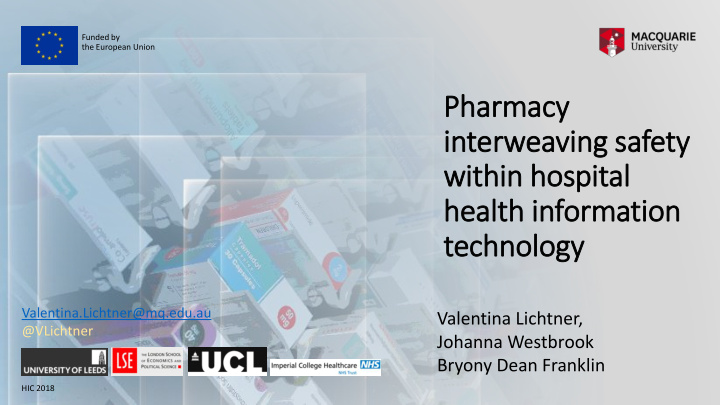



Funded by the European Union Pharmacy interw rweaving safety within hospital health information technology Valentina.Lichtner@mq.edu.au Valentina Lichtner, @VLichtner Johanna Westbrook Bryony Dean Franklin HIC 2018
Overview Medication safety • Background with digital systems in hospital • Aims and Methods is achieved through ongoing • Findings work, building on good • Conclusion usability
Medication safety One of the most serious concerns across all healthcare sectors worldwide 11% of Europeans (*) experienced ‘a serious medical error from a medicine that was prescribed by a doctor’ (*) respondents to Eurobarometer survey European Commission (2016) Medical Errors. Special Eurobarometer 241/Wave 64.1 & 64.3
Medication safety • Improvements by replacing paper-based systems with digital systems • Studies focused on electronic prescribing and administration systems
Digitalisation decision support for precise electronic dosing prescribing stock mobile apps management decision support for as reminders pharmacogenomics for patients robotic barcode dispensing scanning for automated administration cabinets of medicines electronic discharge summaries Delivering Digital Drugs @D3project
Aims • Explore complexities of hospital medication work and processes of digitalisation
Tracer approach : ‘ follow the drugs ’ • objects are followed through the organisation to investigate processes across times and stakeholders and gather information about the whole organisation • they are the starting point for expanding and connecting
The setting • One of the largest NHS hospitals in Stock Mgt England Dispensing • Varied digital medicine systems in use EPR PAS • Implementing an electronic prescribing and administration system (EPMA) with decision support EPMA
Methods 39 Interviews ~103 hours of Documents observations 22 pharmacy Prescribing charts, 11 nursing online drug formulary, 4 medical posters in clinical areas 2 patients Across 8 wards (4 with EPMA), 2 dispensaries, 2 stock management areas
Data analysis (1) • Initial inductive coding • immersion in the data • identification of emerging themes • qualitative analysis software (NVivo) • annotating process maps
Pharmacy medication steps with technology Stock EPMA EPMA EPMA EPMA EPR EPR Mgt Ordering Inpatient Rx Reconciliation at Supply/Stock Medication review medications from completed admission Management Pharmacy Stock EPMA Mgt Administration of Dispensing Pharmacist check Delivery Discharge medication
Data analysis (2) pharmacy key steps towards medication safety issues of non-integrated systems • applying the theoretical lens of usability and cognitive work medication safety as an ongoing achievement 1. Interweaving safety 2. Scaffolding people’s thinking 3. Linking-up unintegrated systems
1 Interweaving safety 1. Setting up medicines information in the system 2. Regularly checking its accuracy and appropriateness during ongoing clinical care • Interweaving work distributed across pharmacists, technicians, support staff and delivery teams • Embedded in multiple electronic medication systems
Cognitive scaffolding* People organize and structure their work environment to facilitate cognitive work, improve efficiency and possibly reduce errors * Andy Clark, 1997
2 Scaffolding people’s thinking Pharmacy staff set up digital systems to scaffold others’ minds (doctors, nurses, other pharmacists, technicians and assistants) … we do all sorts of things like using […] tall man lettering, changing the order of the text, changing the way the [drug] strength is described perhaps, making it longer, making it shorter, whatever it might be… (Pharmacy IT manager)
3 Linking-up systems …we compensate for the lack of joined up technology by using people (Pharmacy manager)
Linking-up systems …That’s [strange]. See, I’ve typed in that number [7654321 ], it looks like that it’s her husband, possibly. Same surname. […] But it’s [male name], and this one’s a [female name]. I think that might be a 2 instead of a 1. Yes. […] it might not have been spotted. (Dispensing technician)
Usability issues • speed : slow response …10 minutes sitting there. Nothing [no response]. …the order you do thing in. And have you checked this. Have you checked that. […] You have it all in your head and make a decision and then write it. (Ward Pharmacist)
Usability issues • long un-differentiated lists of medication …it is quite hard […] to pick [high risk prescribing] out from the clutter of routine... (Ward Pharmacist)
Conclusions A contribution to the ‘conceptual toolbox’ and language of safety in health IT • Interweaving safety work • Cognitive scaffolding
Take away messages • Medication safety is an ongoing distributed achievement based on people’s medication safety-oriented work with technology interweaved through ongoing patient care • Cognitive scaffolding and usability change cognition and decision making • Poor usability risks undermining this safety work
References • Braithwaite, J., R.L. Wears, and E. Hollnagel, Resilient health care: turning patient safety on its head . International Journal for Quality in Health Care, 2015. 27(5): p. 418-20. • Combey, P., A tracer approach to the study of organizations . Journal of Management Studies, 1980. 17(1): p. 96-126. • Clark, A., Being there: putting brain, body, and world together again. 1997, Cambridge, Mass.; London: MIT Press. • Hutchins, E., How a cockpit remembers its speed . Cognitive Science, 1995. 19: p. 265-288. • Lichtner, V., T. Cornford, and E. Klecun. ‘ It’s people heavy’: A Sociotechnical view of hospital discharge. in Proceedings of the 25th European Conference on Information Systems (ECIS). 2017. Portugal. • Lintern, G. and A. Motavalli, Healthcare information systems: the cognitive challenge . BMC Medical Informatics and Decision Making, 2018. 18(1): p. 3. • Perrow, C., Normal accidents: living with high-risk technologies . 1984: Basic Books.
Delivering Digital Drugs @D3project
Recommend
More recommend